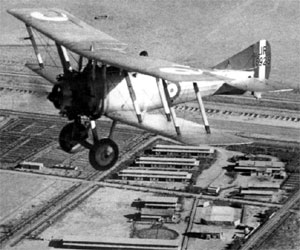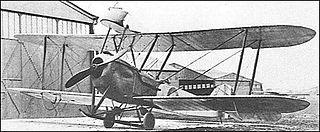
The Sopwith Triplane was a British single seat fighter aircraft designed and manufactured by the Sopwith Aviation Company during the First World War. It has the distinction of being the first military triplane to see operational service.

The Gloster F.5/34 was a British fighter of the 1930s. It was a single-seat, single-engine monoplane of all-metal cantilever construction; the undercarriage was of the tailwheel type with retractable main wheels.

The Armstrong Whitworth F.K.10 was a British two-seat quadruplane fighter aircraft built by Armstrong Whitworth during the First World War. While it was ordered in small numbers for the Royal Flying Corps and Royal Naval Air Service, it was not used operationally. It is one of the few quadruplane aircraft to reach production.

The Fairey Pintail was a British single-engine floatplane fighter of the 1920s. While it was developed by Fairey as a reconnaissance fighter for the Royal Air Force, the only orders placed were for three for the Imperial Japanese Navy.

The Vickers Type 121 Wibault Scout was a British fighter built by Vickers in the 1920s. It was a licensed version of the French Wibault 7 aircraft, with 26 being sold to Chile in 1926, where they served until 1934.

The Martin-Baker MB 2 was a British private-venture fighter prototype based on a simple basic structure that had been developed in the earlier MB 1 civil aircraft. Although briefly evaluated as a fighter by the Royal Air Force, the MB 2 was limited in design potential and never entered series production.

The Nieuport Nighthawk was a British fighter aircraft developed by the Nieuport & General Aircraft company for the Royal Air Force towards the end of the First World War. Although ordered into production before the aircraft first flew, it did not enter large scale service with the RAF owing to unreliable engines. Re-engined aircraft did see service in Greece, serving from 1923 to 1938.

The Vickers F.B.26 Vampire was a British single-seat pusher biplane fighter built by Vickers during the First World War.
The Port Victoria P.V.2 was a British prototype floatplane fighter of the First World War, designed and built at the Royal Naval Air Service's Port Victoria Marine Experimental Aircraft Depot on the Isle of Grain. Only a single aircraft was built, with the type not being chosen for production.
The Port Victoria P.V.7 Grain Kitten was a prototype British Fighter aircraft of the First World War designed and built by the Port Victoria Marine Experimental Aircraft Depot on the Isle of Grain. A very small and light biplane intended to fly off platforms on Royal Navy Destroyers, it was unsuccessful, only a single prototype being built.
The Port Victoria P.V.1 was a British prototype floatplane fighter of the First World War, built at the Royal Naval Air Service's Port Victoria Marine Experimental Aircraft Depot on the Isle of Grain by fitting a Sopwith Baby with high-lift wings. Only a single aircraft was built, with the type not being chosen for production.
The Sopwith B.1 was an experimental British bomber aircraft of the First World War. A single-seat, single-engined biplane, the B.1 was built by the Sopwith Aviation Company for the Royal Navy. Although only two were built, one was used for bombing raids over France.
The Grain Griffin was a British carrier-based reconnaissance aircraft developed and built by the RNAS Marine Experimental Depot, Port Victoria, during the First World War. A development of the unsuccessful Sopwith B.1 bomber, the Grain Griffin was a two-seat single-engined biplane that was built in small numbers for Britain's Royal Naval Air Service, being used operationally during the British intervention in the Russian Civil War.
The Sopwith 2FR.2 Bulldog was a prototype British two-seat fighter of the First World War. A single-engined biplane, the Bulldog was a fighter/reconnaissance aircraft intended to replace the Bristol F.2 Fighter, but was unsuccessful, with no replacement for the Bristol Fighter being purchased.
The Armstrong Whitworth F.K.5 and F.K.6 were experimental triplanes built as escort fighters by Armstrong Whitworth during the First World War. They carried two gunners in nacelles mounted on the centre wing. One example of each type was built, with no further development or production following.

The Vickers F.B.11 was a prototype British three-seat escort fighter of the First World War. A large single-engined biplane, it carried one gunner in a nacelle mounted on the upper wing to give an allround field of fire. Only a single example was completed.
The Port Victoria P.V.9 was a British single-seat biplane floatplane fighter of the First World War. Although claimed to be the best aircraft of its type yet to be tested, only a single prototype was built.
The Port Victoria P.V.4 was a prototype two-seat reconnaissance floatplane of the First World War. The P.V.4 was a small single engined pusher biplane. It was unsuccessful as the engine it was designed around was a failure and alternatives were unsuitable, only one aircraft being built.
The Port Victoria P.V.5 was a British single-engined floatplane fighter aircraft of the First World War. A single example was built and flown at the Royal Naval Air Service's Port Victoria Marine Experimental Aircraft Depot on the Isle of Grain in 1917. Despite demonstrating good manoeuvrability and handling, no production followed, with the Royal Naval Air Service instead using landplanes for the fighter role.

The Wibault 13C.1 Trombe (Whirlwind), later known as the Wib 130C.1 Trombe was a single seat, parasol wing lightweight fighter aircraft designed and built in France in the 1920s. It was developed into the more powerful Wib 170C.1 Tornade (Tornado) but government interest in lightweight fighters soon waned.










